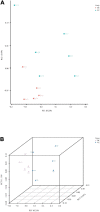Yeast Culture Improves Egg Quality and Reproductive Performance of Aged Breeder Layers by Regulating Gut Microbes
- PMID: 33815314
- PMCID: PMC8018237
- DOI: 10.3389/fmicb.2021.633276
Yeast Culture Improves Egg Quality and Reproductive Performance of Aged Breeder Layers by Regulating Gut Microbes
Abstract
This study aimed to investigate the effects of dietary yeast culture (YC) supplementation on egg production, egg quality, reproductive performance, immune functions, antioxidant capacity, and intestinal microbial structure of aged hens. A total of 224 Hy-Line Brown layers (54 weeks old) were randomly assigned to two dietary treatments. The control group was fed a basal diet and the YC group was supplemented with YC at 2.0 g/kg of their diet. Each group had seven replicates with 16 hens each. The study was conducted over a period of 8 weeks. Results indicated that YC addition had no significant effect on laying performance. However, it significantly improved egg quality and hatching rate, enhanced ileum crude fat digestibility, increased the serum parameters of lysozyme (LZM) and total antioxidation capacity (T-AOC) (P < 0.05), and reduced serum aspartate aminotransferase (AST) levels (P < 0.05). Using 16S rRNA analysis, we found that addition of YC significantly altered ileum microbial composition. Linear discriminant analysis of effect size (LEfSe) showed significant enrichment of Bacilli and Lactobacilli in the YC group. PICRUSt analysis of the ileal microbiota found that glutathione metabolism, ubiquinone, and other terpenoid-quinone biosynthesis and lipopolysaccharide biosynthesis protein pathways were highly enriched in the YC group compared with the basal diet group. In summary, the addition of YC can improve egg quality, immune functions, antioxidant capacity, reproduction efficiency, and digestive absorption by increasing the abundance of Lactobacilli and Bacilli. Furthermore, it also improves the biosynthesis of lipopolysaccharide proteins, glutathione metabolism, and the synthesis of ubiquinone and other terpenoid-quinone metabolic pathways.
Keywords: aged layer; egg quality; microbiome; performance; reproduction; yeast culture.
Copyright © 2021 Liu, Cheng, Zhen, Zeng, Qu, Wang and Ning.
Conflict of interest statement
DZ was employed by company Huayu Agricultural Science and Technology Co., Ltd. The remaining authors declare that the research was conducted in the absence of any commercial or financial relationships that could be construed as a potential conflict of interest.
Figures






Similar articles
-
Multi-Enzyme Supplementation Modifies the Gut Microbiome and Metabolome in Breeding Hens.Front Microbiol. 2021 Dec 3;12:711905. doi: 10.3389/fmicb.2021.711905. eCollection 2021. Front Microbiol. 2021. PMID: 34925250 Free PMC article.
-
Effects of Yeast Culture on Laying Performance, Antioxidant Properties, Intestinal Morphology, and Intestinal Flora of Laying Hens.Antioxidants (Basel). 2024 Jun 27;13(7):779. doi: 10.3390/antiox13070779. Antioxidants (Basel). 2024. PMID: 39061848 Free PMC article.
-
Yeast culture promotes the production of aged laying hens by improving intestinal digestive enzyme activities and the intestinal health status.Poult Sci. 2020 Apr;99(4):2026-2032. doi: 10.1016/j.psj.2019.11.017. Epub 2020 Feb 7. Poult Sci. 2020. PMID: 32241487 Free PMC article.
-
Effect of dietary supplementation of mannan-oligosaccharides on performance, blood metabolites, ileal nutrient digestibility, and gut microflora in Escherichia coli-challenged laying hens.Poult Sci. 2015 Sep;94(9):2165-72. doi: 10.3382/ps/pev180. Epub 2015 Jul 17. Poult Sci. 2015. PMID: 26188028
-
Peppermint extract improves egg production and quality, increases antioxidant capacity, and alters cecal microbiota in late-phase laying hens.Front Microbiol. 2023 Sep 21;14:1252785. doi: 10.3389/fmicb.2023.1252785. eCollection 2023. Front Microbiol. 2023. PMID: 37808324 Free PMC article.
Cited by
-
Multi-Enzyme Supplementation Modifies the Gut Microbiome and Metabolome in Breeding Hens.Front Microbiol. 2021 Dec 3;12:711905. doi: 10.3389/fmicb.2021.711905. eCollection 2021. Front Microbiol. 2021. PMID: 34925250 Free PMC article.
-
Lactobacillus salivarius SNK-6 Activates Intestinal Mucosal Immune System by Regulating Cecal Microbial Community Structure in Laying Hens.Microorganisms. 2022 Jul 20;10(7):1469. doi: 10.3390/microorganisms10071469. Microorganisms. 2022. PMID: 35889188 Free PMC article.
-
Dietary supplementation of compound probiotics to improve performance, egg quality, biochemical parameters and intestinal morphology of laying hens.Front Vet Sci. 2024 Dec 24;11:1505151. doi: 10.3389/fvets.2024.1505151. eCollection 2024. Front Vet Sci. 2024. PMID: 39776595 Free PMC article.
-
Dietary Saccharomyces cerevisiae fermentation product improved egg quality by modulating intestinal health, ovarian function, and cecal microbiota in post-peak laying hens.Poult Sci. 2025 May;104(5):104979. doi: 10.1016/j.psj.2025.104979. Epub 2025 Mar 7. Poult Sci. 2025. PMID: 40073632 Free PMC article.
-
Effect of Yeast Culture on Reproductive Performance, Gut Microbiota, and Milk Composition in Primiparous Sows.Animals (Basel). 2023 Sep 18;13(18):2954. doi: 10.3390/ani13182954. Animals (Basel). 2023. PMID: 37760354 Free PMC article.
References
-
- Aloulou A., Schué M., Puccinelli D., Milano S., Delchambre C., Leblond Y., et al. (2015). Yarrowia lipolytica lipase 2 is stable and highly active in test meals and increases fat absorption in an animal model of pancreatic exocrine insufficiency. Gastroenterology 149 1910.e5–1919.e5. 10.1053/j.gastro.2015.08.047 - DOI - PubMed
LinkOut - more resources
Full Text Sources
Other Literature Sources

